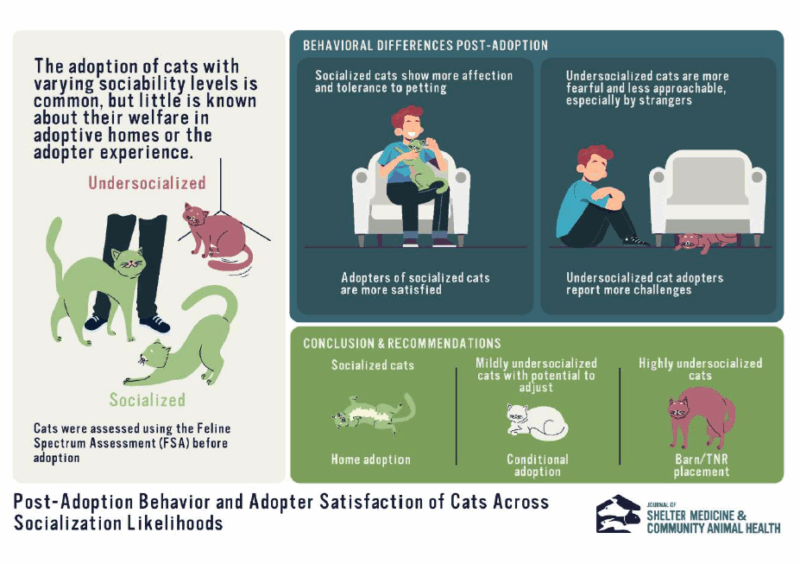
Written By Dr. Jacklyn Ellis, PhD
Many well-meaning cat lovers dream of a world with no homeless cats. While in theory this sounds wonderful, implementation comes with some practical and moral questions for animal shelters. What should they do with adult cats who have had little to no experience with humans and thus do not trust them? Should these cats be socialized and placed into homes? Is this even possible? Is this a good use of these organizations limited resources when other live outcomes for these cats are possible (namely, TNR or alternative placement in a barn or similar environment)? And perhaps most importantly, is this what is in the best interest of the cat (or adopter)? A recent study published in the Journal of Shelter Medicine and Community Animal Health provides compelling insights into the welfare of cats with questionable sociability and how it impacts their post-adoption experience. Let’s explore the key findings of this important study and what they mean for both cats and their human companions.
Key Takeaways from the Study
- The Socialization Spectrum of Cats Cats fall on a socialization spectrum, from those with no prior exposure to humans (unsocialized) to those who are lap cats (fully socialized). The socialization process is complex, and not all cats can become fully comfortable in a home environment, especially if this process starts after they are adults. The study used the Feline Spectrum Assessment (FSA) to categorize cats’ socialization levels based on their behavior towards people.
- The Impact of Socialization on Cat Behavior The study found that cats who were more likely to be undersocialized (as indicated by the FSA) exhibited more fearful behaviors, were less affectionate, and were less amenable to being approached or petted in their subsequent adoptive homes. These behaviors were more pronounced when they encountered strangers, though some of these challenges extended to interactions with their own adopters as well.
- Adopter Satisfaction and Experience Interestingly, the study also revealed that adopters of cats with lower likelihoods of being socialized reported slightly lower levels of satisfaction compared to those adopting more socialized cats. As the likelihood of being undersocialized increased, adopters were also less likely to view a traditional home environment as ideal for their new feline friend.
- Better Welfare for Socialized Cats Cats that were never suspected of being undersocialized experienced better overall welfare, and their adopters were more satisfied. This finding underscores the importance of considering a cat’s socialization level when determining the best outcome pathway.
- Alternative Placement for Undersocialized Cats The study suggests that cats who fall into the “unlikely” or “extremely unlikely” categories for socialization (FSA 1&2) may not be suited for traditional home environments. These cats may be better placed in environments such as barns or through Trap Neuter Return (TNR) programs, where they can live in more natural settings that align with their social capabilities. Such pathways are likely to provide a better quality of life for these cats and reduce the risk of behavioral issues in home environments.
- The Need for Informed Adoption Decisions This study highlights the importance of making informed adoption decisions based on a cat’s behavior and socialization level. While it’s tempting to believe that any cat can thrive in a home environment, it’s crucial to recognize that some cats may require specialized care or alternative placement to ensure their well-being. The FSA provides a helpful tool to make these decisions more objective.
Why This Research Matters
This study is a valuable resource for animal shelters, adoption agencies, and pet owners alike. It emphasizes that not all cats are suited to a traditional home setting, especially those with significant socialization challenges. By utilizing tools like the FSA to assess a cat’s behavior, shelters can make better decisions about whether adoption, TNR, or an alternative placement is the right path for each individual cat.
It also serves as a call to action for future research and improved shelter practices. By focusing on the well-being of both cats and adopters, we can help ensure that every adoption is a success, while also improving the lives of those cats who may not be suited for a home.
A Final Thought: Read and Learn More
If you’re passionate about animal welfare or are involved in shelter work, this study is a must-read. It provides evidence-backed insights into how we can better support both cats and their adopters in the journey from shelter to home. By understanding the nuances of cat socialization, we can improve adoption outcomes and ultimately ensure that both cats and their families thrive. To dive deeper into this fascinating research and explore more about feline behavior and welfare, be sure to check out the full article on the Journal of Shelter Medicine and Community Animal Health website.
References:
Ellis, J. J., Janke, K. J., Furgala, N. M., & Bridge, T. (2025). Post-Adoption Behavior and Adopter Satisfaction of Cats Across Socialization Likelihoods. Journal of Shelter Medicine and Community Animal Health, 4(1).
